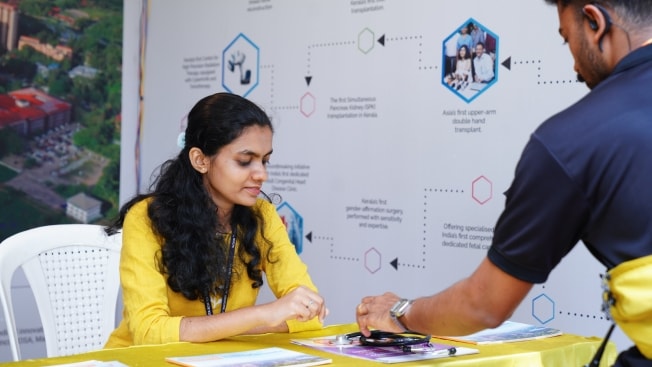
We have introduced a groundbreaking technology for breast cancer detection, revolutionizing the diagnostic process. The newly launched contrast-enhanced mammogram system enables the identification of malignancies before they become visible on a standard mammogram.
The inauguration ceremony, held as part of the World Cancer Day activities at the hospital, witnessed the convergence of patients, clinicians, and foundation members committed to bridging the gap in cancer care.
The advanced mammography technology boasts a 50-degree-wide-angle view, enhanced with contrast for tomosynthesis and biopsy procedures. This state-of-the-art equipment enables faster and more accurate stereotactic biopsies while reducing examination time, improving patient comfort, and supporting early detection. It is the first-of-its-kind facility in Kerala, marking a significant milestone in breast cancer diagnostics.
The 3D imaging technology involved in this device captures multiple images of a compressed breast from various angles within a short scan. These images are then reconstructed into thin, high-resolution slices that can be individually examined or viewed dynamically in a cine-mode. This process enhances the accuracy of diagnosis, reduces breast compression, and facilitates 3D lesion localization.
Expressing their pride in introducing this unique mammogram, Dr. Srikanth Moorthy, Professor and Head of the Department of Radiology, stated, "We are immensely fulfilled to bring this specific type of mammogram, as it opens a new era in cancer imaging diagnostics in this region. Its high sensitivity in detecting early lesions allows us to identify breast cancer before it becomes visible on a standard mammogram, making it a valuable alternative to MRI."
Highlighting the impact of this cutting-edge technology, Dr. Vijayakumar, Head and Professor of the Breast Diseases Division, emphasized that breast cancer is a prevalent malignancy affecting women. The new technology helps penetrate dense breasts and identify malignancies, even in younger age groups, emphasizing the importance of self-examination for early detection.
The digital mammography system offers several significant benefits, including a quick and easy procedure, reduced patient discomfort, and higher accuracy, especially for women aged 40 to 50 years. It also increases the detection of cancer in dense breasts, facilitating early screening in younger age groups. Moreover, it provides a cost-efficient alternative to MRI scans, unless further critical analysis is required. The digital nature of the images enables easy electronic transfer for second opinions and creates a valuable database for teaching and training future generations of medical professionals.
Dr. Pavithran, Professor and Head of Medical Oncology, praised the quality and reliability of Amrita Hospital's breast imaging services. He highlighted the machine's advanced features, such as auto-stabilization, which improves usability, reduces examination time, and enhances patient comfort. The contrast-enhanced 3D imaging capabilities of the system provide high-resolution images and detect even the smallest abnormalities. The affordability of this technology ensures accessibility for a wide range of patients.
The event was inaugurated by actor Tini Tom and Sethu, a prominent scriptwriter and director from the Malayalam film industry. Dr. Anand Kumar A, Vice Principal of Amrita School of Medicine, delivered the presidential address. Distinguished attendees included Rotarian Vinu Vargheese, Assistant Governor of District 3201; Rtn Arun Madhusudhanan, President of the Rotary Club of Kochi United; Dr. Junaid Rahman, President of Cancure; Dr. Manzoor K from the Butterfly Cancer Care Foundation; and Mr. Asanul Banna from the Hope Child Cancer Care Foundation.
Amrita Hospital's breast clinic conducts nearly 6000 mammograms with digital breast tomosynthesis (DBT) annually, along with a minimum of 500 image-guided procedures. The introduction of this advanced technology reaffirms the hospital's commitment to providing exceptional care through a combination of research-driven approaches, precise technology, and patient-centric focus.


